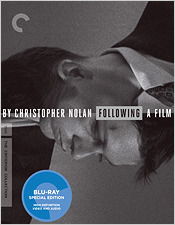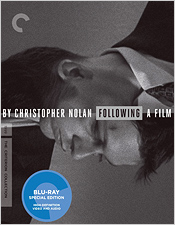Following (Blu-ray Review)

Director
Christopher NolanRelease Date(s)
1999 (December 11, 2012)Studio(s)
IFC Films (Criterion - Spine #638)- Film/Program Grade: A
- Video Grade: A
- Audio Grade: A
- Extras Grade: A
Review
Possible Spoilers Ahead
Following is Christopher Nolan’s feature film debut from 1998. He would follow it up with Memento in 2000 and a remake of Insomnia in 2002 before launching head-first into the big time, but this was a period when Nolan was learning the ropes of feature films. He had been dabbling in short films, but it wasn’t until Following came along that people began to take notice of the young filmmaker.
Following was a project that Nolan had put together using what little money he had to work with at the time. He shot the film on 16mm film in black and white and kept the production values as low as possible by using real locations and rehearsing with the actors extensively before the cameras rolled so as to not waste precious film stock. Story-wise, it’s a blueprint for Memento. Not that it tells the story in the same way or that it features the same characters, but you can certainly see the similarities in the narrative. While the film does take a bit of time to get going and eventually pays off while our lead character gets in over his head, the film as a whole doesn’t totally work on a narrative level. That shouldn’t come as a surprise to most people who tend to hate on Nolan for a being a bit sloppy in the details, but it works well enough for what it is.
The story is about a young writer, played by Jeremy Theobald, who becomes bored with what he’s writing and decides to follow random strangers all over London and observe them in their routines. He does this for writing material, but when he’s caught by Alex Haw’s character who turns out to be a criminal, he begins to follow him around as Haw’s character robs apartments all over town. Eventually, things get out of control and our lead falls for a life of crime.
The problem that I have with this story is that I don’t really buy Theobald’s character suddenly having an urge to steal, but I think that’s part of the conceit of the story. He’s so curious about Haw’s character and what he does that he loses sight of what his original intentions were. He also falls for one of the people that he’s following and gets involved in a convoluted scheme in which he risks everything. I found it kind of unbelievable though because it’s just amazing to me how a know-nothing writer who’s simply looking for something to write about suddenly becomes a corrupt individual. The thing is though that there’s a question mark at the end of the film as to whether or not Alex Haw’s character actually existed at all, and that Theobald’s character may have been doing this himself all along. It’s very Fight Club in that sense, but it’s neither explored nor answered for the audience. But if that’s what’s really going on, then the plot of the film doesn’t make a whole lot of sense. So I’m disregarding that theory and just simply sticking with what’s on the surface, but even so, what’s on the surface isn’t concrete enough.
But you have to get past these things because this was a first-time film for its director, so you can’t expect any kind of perfection the first time out. No film is perfect, of course, but the motivations of the actors needed to be a little more blatant and a little less sketchy. I know it’s a bit of a mystery, and it’s unfolding for us as the film goes on, but the whys and hows added up too quickly. But overall, the film is a very good noir tale that fans of Nolan’s work are likely to enjoy.
Because the film was shot on 16mm film stock and in black and white, as previously stated, I wasn’t sure what to expect with the transfer. I was optimistic though because Christopher Nolan personally supervised that transfer himself, so what you’re getting are his true intentions. That being said, the picture quality is quite tremendous. It’s windowboxed because of the format, but every fine bit of detail can be seen. Grain detail is abundant and the contrast is perfect. This is probably the best-looking 16mm film I’ve seen recently and the detail on display here is leaps and bounds above what is normally a poor film stock to shoot with when it comes to picture quality (especially high definition). For the audio portion, you get two options: the original English mono track and a new English 5.1 DTS-HD track. I checked both out, and while the DTS track certainly has a little more life in it, the mono track is pretty impressive. One thing of note is the lack of Foley on the soundtrack but yet the sound effects all sound top of the line. Both tracks are quite good, but if you’re a purist, at least you have the original audio to choose from. There are also subtitles in English for those who need them.
As for the supplements, you get a pretty darned good assortment. There’s an audio commentary with Christopher Nolan, as well as an interview with him; an option to watch a linear edit of the film; a script to film side-by-side comparison; Christopher Nolan’s short film Doodlebug; the theatrical trailer; the re-release trailer; and a fold-out insert booklet with an essay by film critic and programmer Scott Foundas. When all’s said and done, Following from Criterion is a very good release, and both fans and non-fans should find plenty of good things to discover.
- Tim Salmons

